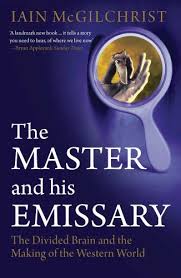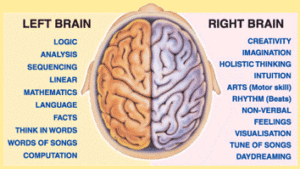
I mentioned I had come across a very interesting book that has enabled me to ground my arguments in my new manuscript even further than I had previously. I did not mean to keep the book a secret. I was waiting until a better time to discuss it. The book is *The Master and his Emissary; The Divided Brain and the Making of the Western World* (Yale University Press), by Iain McGilchrist. The author is a British psychiatrist and Professor of English. The book is an amazing amalgam of his scientific thinking and ability to present ideas that challenge one’s thinking about how we do think.
McGilchrist revivifies the lateralization theory of how the brain works, developed in the 1960’s by Roger Sperry and his colleagues. Working with patients with seizures whose left and right hemispheres had been separated by cutting the corpus callosum, the band that normally connects the two halves, they found that each side functioned differently from the other. This led to a pop psychological theory about brain-sidedness, similar to handedness, where each side performs differently. The diagram illustrates the conventional assignment of functions to the hemispheres.

The idea has persisted, but not without much skepticism among neuroscientists. After reading McGilchrist’s book, I, for one, am sold on the model of two distinct hemispheres, not quite as shown in the diagram, but close. His goes further and claims that the pattern of historic cultural behaviors has been shaped by whichever hemisphere dominates. In particular, he argues that the present culture of the West is the result of left-brain dominance, whereas the more fundamental situation for humans is the opposite. The brain and the world interact in a kind of hermeneutic circle. The state of the brain determines what kind of world we see, that is what we pick out to focus our attention and intentions upon. McGilchrist writes
We bring about a world in consciousness that is partly what is given, and partly what we bring, something that comes into being through this particular conjunction and no other. And the key to this is the kind of attention we pay to the world.
The kind of world we perceive and our subsequent behavior depend on which side is at work. The left side produces a mechanistic model of the world; the right a holistic one. The left is analytic and utilitarian; the right caring and empathetic. If you have been following my own work, you would see these two sides as representing two paradigms, modernity and a yet-to-be named paradigm of caring. Flourishing, the fulfillment of human potential, can exist only in the latter. I have come to this conclusion based largely on philosophical and sociological arguments. What I find so remarkable about his book is that it lays a solid foundation for the existence of these two contrasting worlds in the brain and its two different patterns of perception and response. McGilchrist argues that the right side is the Master in the sense that caring is the more fundamental human disposition to the world, but has become overmatched by the left. We need both to survive and evolve culturally as the left allows us to construct the technological world we have come to inhabit.
The right captures the present moment in its context-rich fullness. It feeds the left as experiences become familiar through repetition. It is the site of the present, the new. McGilchrist lists the following as attributes of the world it creates: presenting, new, whole, integration, context, things/individuals, personal, living, and contemporaneous. He finds that his model parallels Heidegger’s sense of Being. Heidegger speaks about “presencing” as a verb, that is, bringing the whole immediate world into consciousness. I find this quite the same as the author’s use of “presenting” as in the idea of the right side displaying a picture of the immediate world with all of its context and integrity to an imaginary actor sitting in the skull.
The left “re-presents” old facts that have been abstracted from experience and generalized. It is like a scientist who breaks down phenomena into small life-less pieces, each with its own set of features. The left cannot make sense out of incoming sensory inputs except by some sort of comparison with whatever is already known and resides there. The list of its attributes includes: re-presenting, known, part, division, abstraction, and categories, impersonal, non-living and timeless. The left-hemisphere-dominated human is the familiar Homo sapiens or Homo economicus or Homo faber, all names given to our species by various scholars. The right-hemisphere-dominated human sees and behaves so differently that it might justify giving it a distinct species name, Homo amans, coined by Humberto Maturana, to describe the distinctive loving, caring, connected stance. I have started to use the term Homo caritas.
While McGilchrist serves as a rich source of understanding as to how modern humans are the way they are, the key point for me is his argument that dominance has shifted over time. I find no mention of any genetic cause for the choice of dominant hemisphere. If we can go from right to left, I see no fundamental obstacle to reversing the balance. As messy as the world of today has become, I can remain hopeful that we can work our way back to a right-hemisphere world of care and context, and via that, the possibility of flourishing.
More to come.